Gender Inequality in Treatment Procedure
VerifiedAdded on 2023/01/13
|13
|4109
|1
AI Summary
This essay discusses the concept of gender inequality in treatment procedures in healthcare, specifically in mental health. It explores sociological theories and intersectionality and their impact on the treatment of mental health patients. The essay also highlights the disparities in care delivery based on gender.
Contribute Materials
Your contribution can guide someone’s learning journey. Share your
documents today.

Running head: GENDER INEQUALITY IN TREATMENT PROCEDURE
Gender Inequality in Treatment Procedure
Name of the Student
Name of the University
Author Note
Gender Inequality in Treatment Procedure
Name of the Student
Name of the University
Author Note
Secure Best Marks with AI Grader
Need help grading? Try our AI Grader for instant feedback on your assignments.
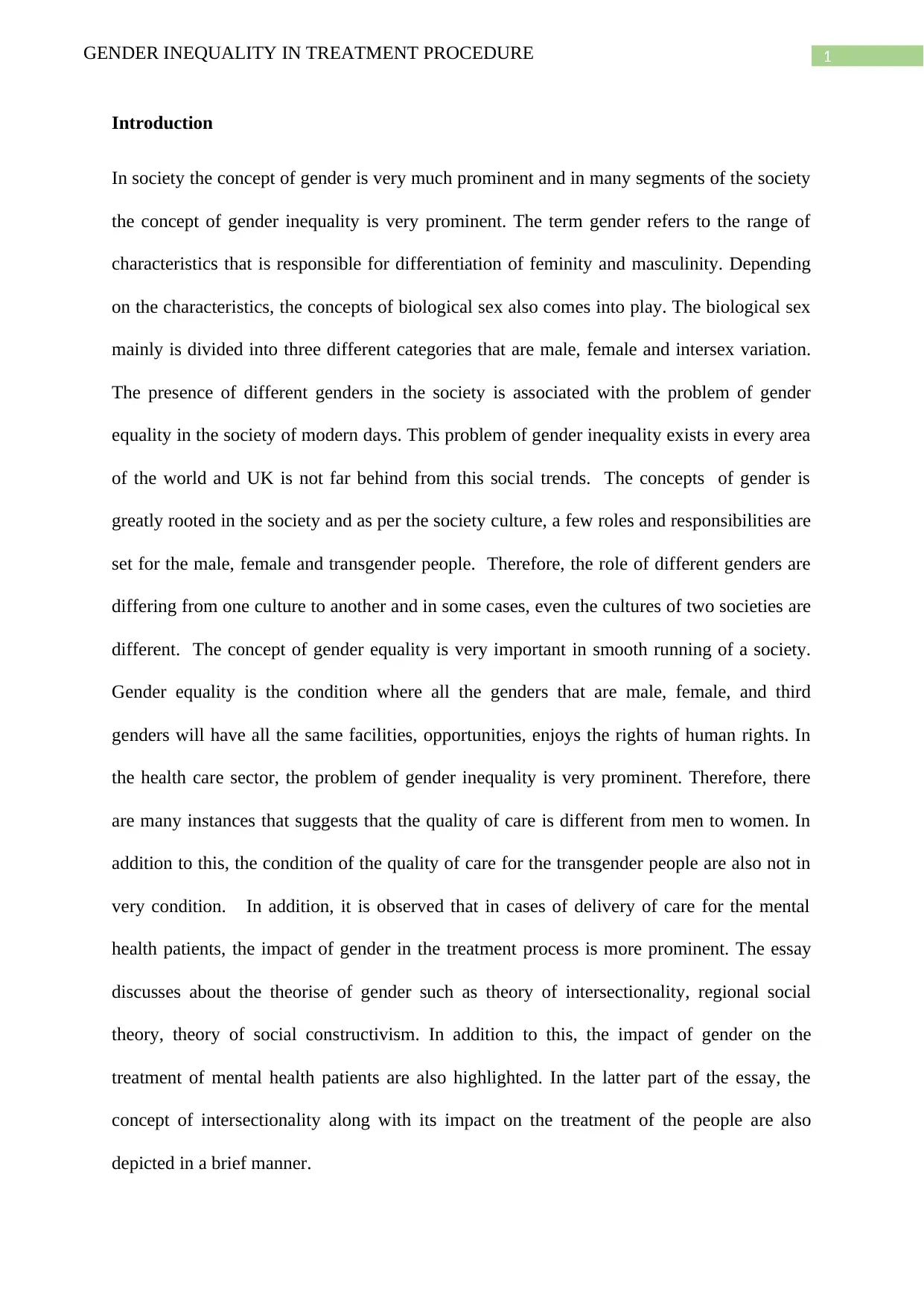
1GENDER INEQUALITY IN TREATMENT PROCEDURE
Introduction
In society the concept of gender is very much prominent and in many segments of the society
the concept of gender inequality is very prominent. The term gender refers to the range of
characteristics that is responsible for differentiation of feminity and masculinity. Depending
on the characteristics, the concepts of biological sex also comes into play. The biological sex
mainly is divided into three different categories that are male, female and intersex variation.
The presence of different genders in the society is associated with the problem of gender
equality in the society of modern days. This problem of gender inequality exists in every area
of the world and UK is not far behind from this social trends. The concepts of gender is
greatly rooted in the society and as per the society culture, a few roles and responsibilities are
set for the male, female and transgender people. Therefore, the role of different genders are
differing from one culture to another and in some cases, even the cultures of two societies are
different. The concept of gender equality is very important in smooth running of a society.
Gender equality is the condition where all the genders that are male, female, and third
genders will have all the same facilities, opportunities, enjoys the rights of human rights. In
the health care sector, the problem of gender inequality is very prominent. Therefore, there
are many instances that suggests that the quality of care is different from men to women. In
addition to this, the condition of the quality of care for the transgender people are also not in
very condition. In addition, it is observed that in cases of delivery of care for the mental
health patients, the impact of gender in the treatment process is more prominent. The essay
discusses about the theorise of gender such as theory of intersectionality, regional social
theory, theory of social constructivism. In addition to this, the impact of gender on the
treatment of mental health patients are also highlighted. In the latter part of the essay, the
concept of intersectionality along with its impact on the treatment of the people are also
depicted in a brief manner.
Introduction
In society the concept of gender is very much prominent and in many segments of the society
the concept of gender inequality is very prominent. The term gender refers to the range of
characteristics that is responsible for differentiation of feminity and masculinity. Depending
on the characteristics, the concepts of biological sex also comes into play. The biological sex
mainly is divided into three different categories that are male, female and intersex variation.
The presence of different genders in the society is associated with the problem of gender
equality in the society of modern days. This problem of gender inequality exists in every area
of the world and UK is not far behind from this social trends. The concepts of gender is
greatly rooted in the society and as per the society culture, a few roles and responsibilities are
set for the male, female and transgender people. Therefore, the role of different genders are
differing from one culture to another and in some cases, even the cultures of two societies are
different. The concept of gender equality is very important in smooth running of a society.
Gender equality is the condition where all the genders that are male, female, and third
genders will have all the same facilities, opportunities, enjoys the rights of human rights. In
the health care sector, the problem of gender inequality is very prominent. Therefore, there
are many instances that suggests that the quality of care is different from men to women. In
addition to this, the condition of the quality of care for the transgender people are also not in
very condition. In addition, it is observed that in cases of delivery of care for the mental
health patients, the impact of gender in the treatment process is more prominent. The essay
discusses about the theorise of gender such as theory of intersectionality, regional social
theory, theory of social constructivism. In addition to this, the impact of gender on the
treatment of mental health patients are also highlighted. In the latter part of the essay, the
concept of intersectionality along with its impact on the treatment of the people are also
depicted in a brief manner.

2GENDER INEQUALITY IN TREATMENT PROCEDURE
a. Sociological theory- This theory provides a set of ideas that clearly sets out to describe the
human society. It is important to note that the theory can be selective in terms of the
perspectives and priorities, the data also define them to be significant. The sociological
theory stresses on the importance of the distinction of the social action theories and structural
theories. The macro or the structural perspective analysis provides the way society as a whole
fit together. The social construction of gender can be described as the perspective in
sociology and feminism (Martindale 2013). This view or the theory highlights that culture
and society have created the specific role for gender and at the same time this theory specifies
the appropriate and ideal behaviour of a person or that of a specific sex. The social
constructionism highlights the ways in which the cultural categories like the white, black,
women, and men concepts are created, reproduced and changed. The approach of this theory
is to focus on the idea that the society is created creatively and actively produced by the
humans (Ritzer and Stepnisky 2017).
Intersectionality theory is a feminist theory, the developed to address the oppressive
and the discriminative institutions of the minorities and the disenfranchised groups. The
theory is based on the oppressive institutions that exist in a society and the take in to account
of issues like the homophobia, sexism, ageism and racism. This theory is based on the gender
discrimination and racial discrimination that are influenced by one another. Thus, it is
important to mention that the social theory provides a context that helps in interpreting the
health patterns (Bauer 2014). Feminism is a broad theory that provides a wide variety of
structures and it enables to understand the position of women in society. The feminists
always highlight that the society always disadvantages the women by limiting and
constraining their opportunities. This is enforced through the domination of the ideas, beliefs,
and theories that justify and support the subordinate position relation to the men. Although
the society has progressed a lot, the feminist theory stresses that women are still exploited by
a. Sociological theory- This theory provides a set of ideas that clearly sets out to describe the
human society. It is important to note that the theory can be selective in terms of the
perspectives and priorities, the data also define them to be significant. The sociological
theory stresses on the importance of the distinction of the social action theories and structural
theories. The macro or the structural perspective analysis provides the way society as a whole
fit together. The social construction of gender can be described as the perspective in
sociology and feminism (Martindale 2013). This view or the theory highlights that culture
and society have created the specific role for gender and at the same time this theory specifies
the appropriate and ideal behaviour of a person or that of a specific sex. The social
constructionism highlights the ways in which the cultural categories like the white, black,
women, and men concepts are created, reproduced and changed. The approach of this theory
is to focus on the idea that the society is created creatively and actively produced by the
humans (Ritzer and Stepnisky 2017).
Intersectionality theory is a feminist theory, the developed to address the oppressive
and the discriminative institutions of the minorities and the disenfranchised groups. The
theory is based on the oppressive institutions that exist in a society and the take in to account
of issues like the homophobia, sexism, ageism and racism. This theory is based on the gender
discrimination and racial discrimination that are influenced by one another. Thus, it is
important to mention that the social theory provides a context that helps in interpreting the
health patterns (Bauer 2014). Feminism is a broad theory that provides a wide variety of
structures and it enables to understand the position of women in society. The feminists
always highlight that the society always disadvantages the women by limiting and
constraining their opportunities. This is enforced through the domination of the ideas, beliefs,
and theories that justify and support the subordinate position relation to the men. Although
the society has progressed a lot, the feminist theory stresses that women are still exploited by
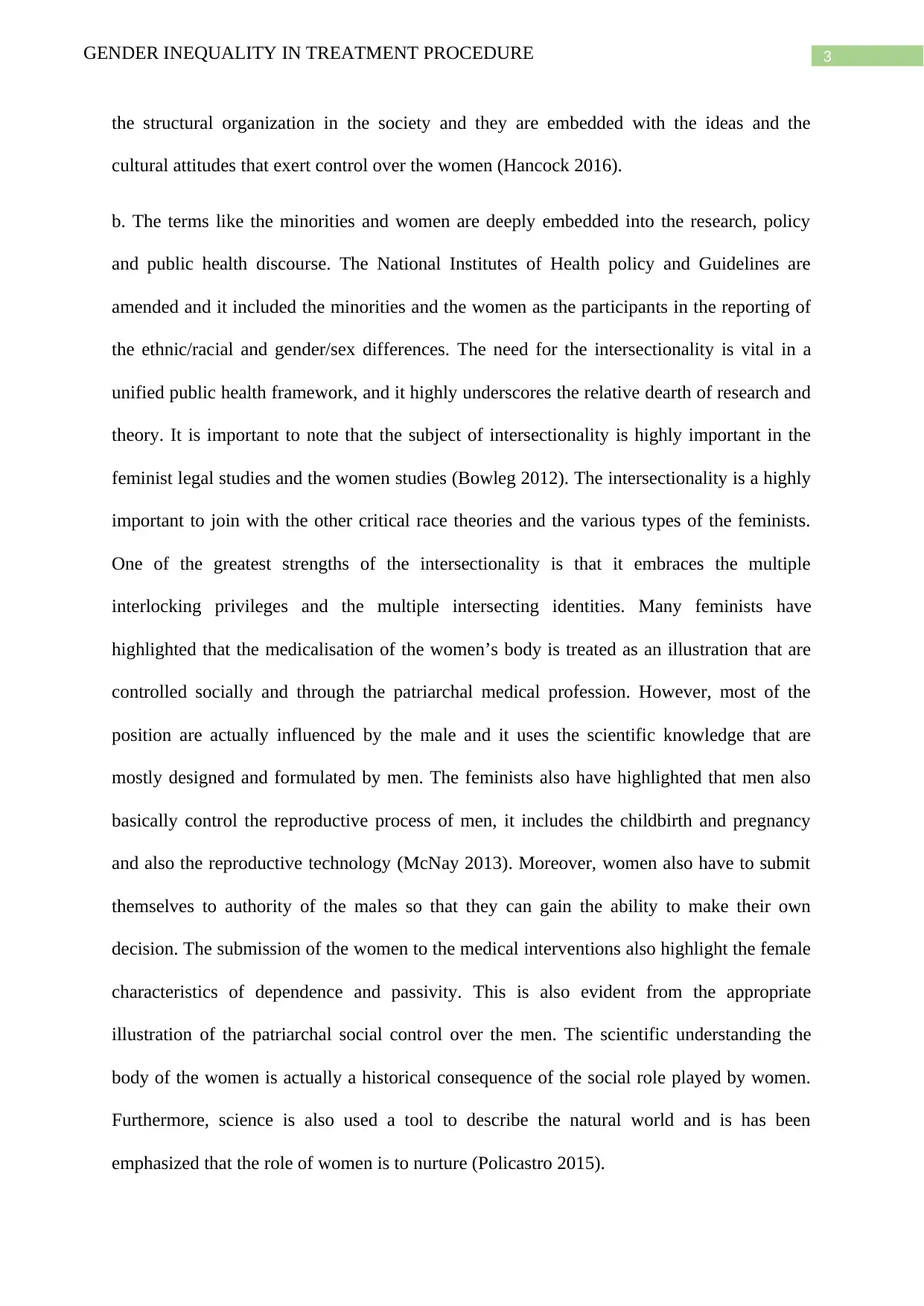
3GENDER INEQUALITY IN TREATMENT PROCEDURE
the structural organization in the society and they are embedded with the ideas and the
cultural attitudes that exert control over the women (Hancock 2016).
b. The terms like the minorities and women are deeply embedded into the research, policy
and public health discourse. The National Institutes of Health policy and Guidelines are
amended and it included the minorities and the women as the participants in the reporting of
the ethnic/racial and gender/sex differences. The need for the intersectionality is vital in a
unified public health framework, and it highly underscores the relative dearth of research and
theory. It is important to note that the subject of intersectionality is highly important in the
feminist legal studies and the women studies (Bowleg 2012). The intersectionality is a highly
important to join with the other critical race theories and the various types of the feminists.
One of the greatest strengths of the intersectionality is that it embraces the multiple
interlocking privileges and the multiple intersecting identities. Many feminists have
highlighted that the medicalisation of the women’s body is treated as an illustration that are
controlled socially and through the patriarchal medical profession. However, most of the
position are actually influenced by the male and it uses the scientific knowledge that are
mostly designed and formulated by men. The feminists also have highlighted that men also
basically control the reproductive process of men, it includes the childbirth and pregnancy
and also the reproductive technology (McNay 2013). Moreover, women also have to submit
themselves to authority of the males so that they can gain the ability to make their own
decision. The submission of the women to the medical interventions also highlight the female
characteristics of dependence and passivity. This is also evident from the appropriate
illustration of the patriarchal social control over the men. The scientific understanding the
body of the women is actually a historical consequence of the social role played by women.
Furthermore, science is also used a tool to describe the natural world and is has been
emphasized that the role of women is to nurture (Policastro 2015).
the structural organization in the society and they are embedded with the ideas and the
cultural attitudes that exert control over the women (Hancock 2016).
b. The terms like the minorities and women are deeply embedded into the research, policy
and public health discourse. The National Institutes of Health policy and Guidelines are
amended and it included the minorities and the women as the participants in the reporting of
the ethnic/racial and gender/sex differences. The need for the intersectionality is vital in a
unified public health framework, and it highly underscores the relative dearth of research and
theory. It is important to note that the subject of intersectionality is highly important in the
feminist legal studies and the women studies (Bowleg 2012). The intersectionality is a highly
important to join with the other critical race theories and the various types of the feminists.
One of the greatest strengths of the intersectionality is that it embraces the multiple
interlocking privileges and the multiple intersecting identities. Many feminists have
highlighted that the medicalisation of the women’s body is treated as an illustration that are
controlled socially and through the patriarchal medical profession. However, most of the
position are actually influenced by the male and it uses the scientific knowledge that are
mostly designed and formulated by men. The feminists also have highlighted that men also
basically control the reproductive process of men, it includes the childbirth and pregnancy
and also the reproductive technology (McNay 2013). Moreover, women also have to submit
themselves to authority of the males so that they can gain the ability to make their own
decision. The submission of the women to the medical interventions also highlight the female
characteristics of dependence and passivity. This is also evident from the appropriate
illustration of the patriarchal social control over the men. The scientific understanding the
body of the women is actually a historical consequence of the social role played by women.
Furthermore, science is also used a tool to describe the natural world and is has been
emphasized that the role of women is to nurture (Policastro 2015).
Secure Best Marks with AI Grader
Need help grading? Try our AI Grader for instant feedback on your assignments.

4GENDER INEQUALITY IN TREATMENT PROCEDURE
C. The issue of mental health disorders has become one of the major cause of public health
concern in the world. The report of the WHO also suggested that, mental health disorder has
become one of the major contributors of mortality and morbidity in the world. Gender is one
of the most crucial determinants of health and it can influence the control and power of
women and men over the mental health determinants. The influence is based on the role,
social status, and socioeconomic condition of the patients. Therefore it can be said that
gender has become one of the most impactful factor on the treatment process of the mental
health patients. It is true that both men and women have fundamental right to get equal
treatment. However, in most of the cases, it is observed that the gender is bias and
stereotyping is present in the treatment and diagnosis of mental health patients. Along with
this, it is also observed that, the mental health disorders are also more diagnose among the
female patients than that of the male patients. In various studies it is observed that in the
treatment of mental health disorders, the inequality still exists. According to the study of Yu
(2018), it is reported that, the women are more vulnerable to have a mental health problem
than that of that male patient in the world. The gender disparity in the treatment of mental
health patients, is observed in different geographical, socio economic condition, populations,
social condition. The study explores the fact that in the treatment of mental health patients ,
the effects of gender inequality is altering the treatment process in a huge way. This study
result showed that, the gender inequality has great impact in on the mental health treatment
and this fact is supported by the significant correlation between the RRFM and the GII index
(1.043 [1.034, 1.053], P-value < 0.001). This study showed that, the gender inequality is may
be correlated with the higher DDRP for the female patients (P-value = 0.061) and the lower
DDRP value for male also suggested that gender inequality is less associated with the mental
health treatment of males (P-value = 0.180). Moreover, it is also reported that, the gender
inequality towards the female also secondarily promotes the prevalence rate of mental health
C. The issue of mental health disorders has become one of the major cause of public health
concern in the world. The report of the WHO also suggested that, mental health disorder has
become one of the major contributors of mortality and morbidity in the world. Gender is one
of the most crucial determinants of health and it can influence the control and power of
women and men over the mental health determinants. The influence is based on the role,
social status, and socioeconomic condition of the patients. Therefore it can be said that
gender has become one of the most impactful factor on the treatment process of the mental
health patients. It is true that both men and women have fundamental right to get equal
treatment. However, in most of the cases, it is observed that the gender is bias and
stereotyping is present in the treatment and diagnosis of mental health patients. Along with
this, it is also observed that, the mental health disorders are also more diagnose among the
female patients than that of the male patients. In various studies it is observed that in the
treatment of mental health disorders, the inequality still exists. According to the study of Yu
(2018), it is reported that, the women are more vulnerable to have a mental health problem
than that of that male patient in the world. The gender disparity in the treatment of mental
health patients, is observed in different geographical, socio economic condition, populations,
social condition. The study explores the fact that in the treatment of mental health patients ,
the effects of gender inequality is altering the treatment process in a huge way. This study
result showed that, the gender inequality has great impact in on the mental health treatment
and this fact is supported by the significant correlation between the RRFM and the GII index
(1.043 [1.034, 1.053], P-value < 0.001). This study showed that, the gender inequality is may
be correlated with the higher DDRP for the female patients (P-value = 0.061) and the lower
DDRP value for male also suggested that gender inequality is less associated with the mental
health treatment of males (P-value = 0.180). Moreover, it is also reported that, the gender
inequality towards the female also secondarily promotes the prevalence rate of mental health

5GENDER INEQUALITY IN TREATMENT PROCEDURE
disorder among the female. In another study by Ranney et al. (2015), the impact of gender on
the mental illness patients in the emergency department was highlighted. In this study, it was
reported that, due to the impact of gender in the treatment process of mental health disorders
like depression. It was observed that, the documentation of self-harm among the female is
much less than that of the male and it affected the documentation rate of the mental health
screening. On the other hand the study of Schuch et al. (2014), showed that there is no
inequality in case of receiving treatment among the male and female mental health patients in
their study. On the other hand, in another report, it was noted that, the in case of getting
antidepressant medication management, the women are slightly ahead of the male patients. In
this case, it was observed that, almost 68.6% of women had received such medication and
66.8% of male patients had received such kind of treatment and there were significant
difference in receiving such treatments with a significant p value of < 0.05. The continuation
phase of anti-depressant medication also showed that higher percentage of women were given
that treatment than the male patients (Women- 53.7% , men- 51.8%; p value of <0.05). In
another study by Zeigler et al. (2014), it was reported that, there is differences in treatment
attitudes in terms of gender differences among the subject population. In this study, 186
African – American and white subjects are recruited as subjects who have clinically
significant depression. All the subjects are recommended for anti-depressant medication.
The attitudes and beliefs of the patients are assessed by using a brief medication
questionnaire. The study result showed that the African- American women has less
knowledge than that of the white women. Along with this, it was also found that, the African
women had received less amount of treatment than that of the male subjects of this study.
The race of the subjects also contributed to the differences in the treatment process of those
mental health patients. The study of Hahm and Brutus ( 2014) suggested that, female are
generally neglected in receiving care for mental health problems. In this study, the authors,
disorder among the female. In another study by Ranney et al. (2015), the impact of gender on
the mental illness patients in the emergency department was highlighted. In this study, it was
reported that, due to the impact of gender in the treatment process of mental health disorders
like depression. It was observed that, the documentation of self-harm among the female is
much less than that of the male and it affected the documentation rate of the mental health
screening. On the other hand the study of Schuch et al. (2014), showed that there is no
inequality in case of receiving treatment among the male and female mental health patients in
their study. On the other hand, in another report, it was noted that, the in case of getting
antidepressant medication management, the women are slightly ahead of the male patients. In
this case, it was observed that, almost 68.6% of women had received such medication and
66.8% of male patients had received such kind of treatment and there were significant
difference in receiving such treatments with a significant p value of < 0.05. The continuation
phase of anti-depressant medication also showed that higher percentage of women were given
that treatment than the male patients (Women- 53.7% , men- 51.8%; p value of <0.05). In
another study by Zeigler et al. (2014), it was reported that, there is differences in treatment
attitudes in terms of gender differences among the subject population. In this study, 186
African – American and white subjects are recruited as subjects who have clinically
significant depression. All the subjects are recommended for anti-depressant medication.
The attitudes and beliefs of the patients are assessed by using a brief medication
questionnaire. The study result showed that the African- American women has less
knowledge than that of the white women. Along with this, it was also found that, the African
women had received less amount of treatment than that of the male subjects of this study.
The race of the subjects also contributed to the differences in the treatment process of those
mental health patients. The study of Hahm and Brutus ( 2014) suggested that, female are
generally neglected in receiving care for mental health problems. In this study, the authors,
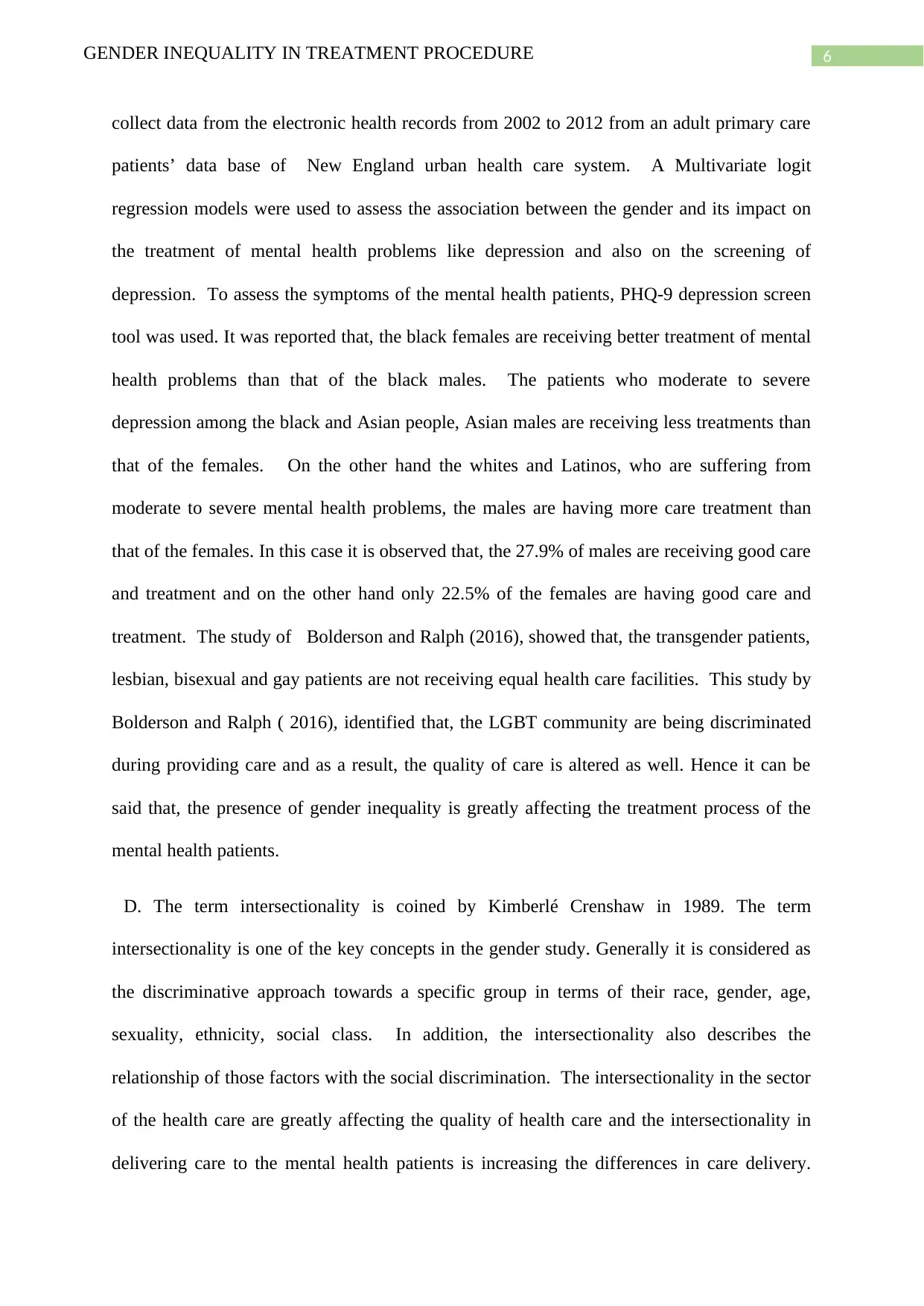
6GENDER INEQUALITY IN TREATMENT PROCEDURE
collect data from the electronic health records from 2002 to 2012 from an adult primary care
patients’ data base of New England urban health care system. A Multivariate logit
regression models were used to assess the association between the gender and its impact on
the treatment of mental health problems like depression and also on the screening of
depression. To assess the symptoms of the mental health patients, PHQ-9 depression screen
tool was used. It was reported that, the black females are receiving better treatment of mental
health problems than that of the black males. The patients who moderate to severe
depression among the black and Asian people, Asian males are receiving less treatments than
that of the females. On the other hand the whites and Latinos, who are suffering from
moderate to severe mental health problems, the males are having more care treatment than
that of the females. In this case it is observed that, the 27.9% of males are receiving good care
and treatment and on the other hand only 22.5% of the females are having good care and
treatment. The study of Bolderson and Ralph (2016), showed that, the transgender patients,
lesbian, bisexual and gay patients are not receiving equal health care facilities. This study by
Bolderson and Ralph ( 2016), identified that, the LGBT community are being discriminated
during providing care and as a result, the quality of care is altered as well. Hence it can be
said that, the presence of gender inequality is greatly affecting the treatment process of the
mental health patients.
D. The term intersectionality is coined by Kimberlé Crenshaw in 1989. The term
intersectionality is one of the key concepts in the gender study. Generally it is considered as
the discriminative approach towards a specific group in terms of their race, gender, age,
sexuality, ethnicity, social class. In addition, the intersectionality also describes the
relationship of those factors with the social discrimination. The intersectionality in the sector
of the health care are greatly affecting the quality of health care and the intersectionality in
delivering care to the mental health patients is increasing the differences in care delivery.
collect data from the electronic health records from 2002 to 2012 from an adult primary care
patients’ data base of New England urban health care system. A Multivariate logit
regression models were used to assess the association between the gender and its impact on
the treatment of mental health problems like depression and also on the screening of
depression. To assess the symptoms of the mental health patients, PHQ-9 depression screen
tool was used. It was reported that, the black females are receiving better treatment of mental
health problems than that of the black males. The patients who moderate to severe
depression among the black and Asian people, Asian males are receiving less treatments than
that of the females. On the other hand the whites and Latinos, who are suffering from
moderate to severe mental health problems, the males are having more care treatment than
that of the females. In this case it is observed that, the 27.9% of males are receiving good care
and treatment and on the other hand only 22.5% of the females are having good care and
treatment. The study of Bolderson and Ralph (2016), showed that, the transgender patients,
lesbian, bisexual and gay patients are not receiving equal health care facilities. This study by
Bolderson and Ralph ( 2016), identified that, the LGBT community are being discriminated
during providing care and as a result, the quality of care is altered as well. Hence it can be
said that, the presence of gender inequality is greatly affecting the treatment process of the
mental health patients.
D. The term intersectionality is coined by Kimberlé Crenshaw in 1989. The term
intersectionality is one of the key concepts in the gender study. Generally it is considered as
the discriminative approach towards a specific group in terms of their race, gender, age,
sexuality, ethnicity, social class. In addition, the intersectionality also describes the
relationship of those factors with the social discrimination. The intersectionality in the sector
of the health care are greatly affecting the quality of health care and the intersectionality in
delivering care to the mental health patients is increasing the differences in care delivery.
Paraphrase This Document
Need a fresh take? Get an instant paraphrase of this document with our AI Paraphraser
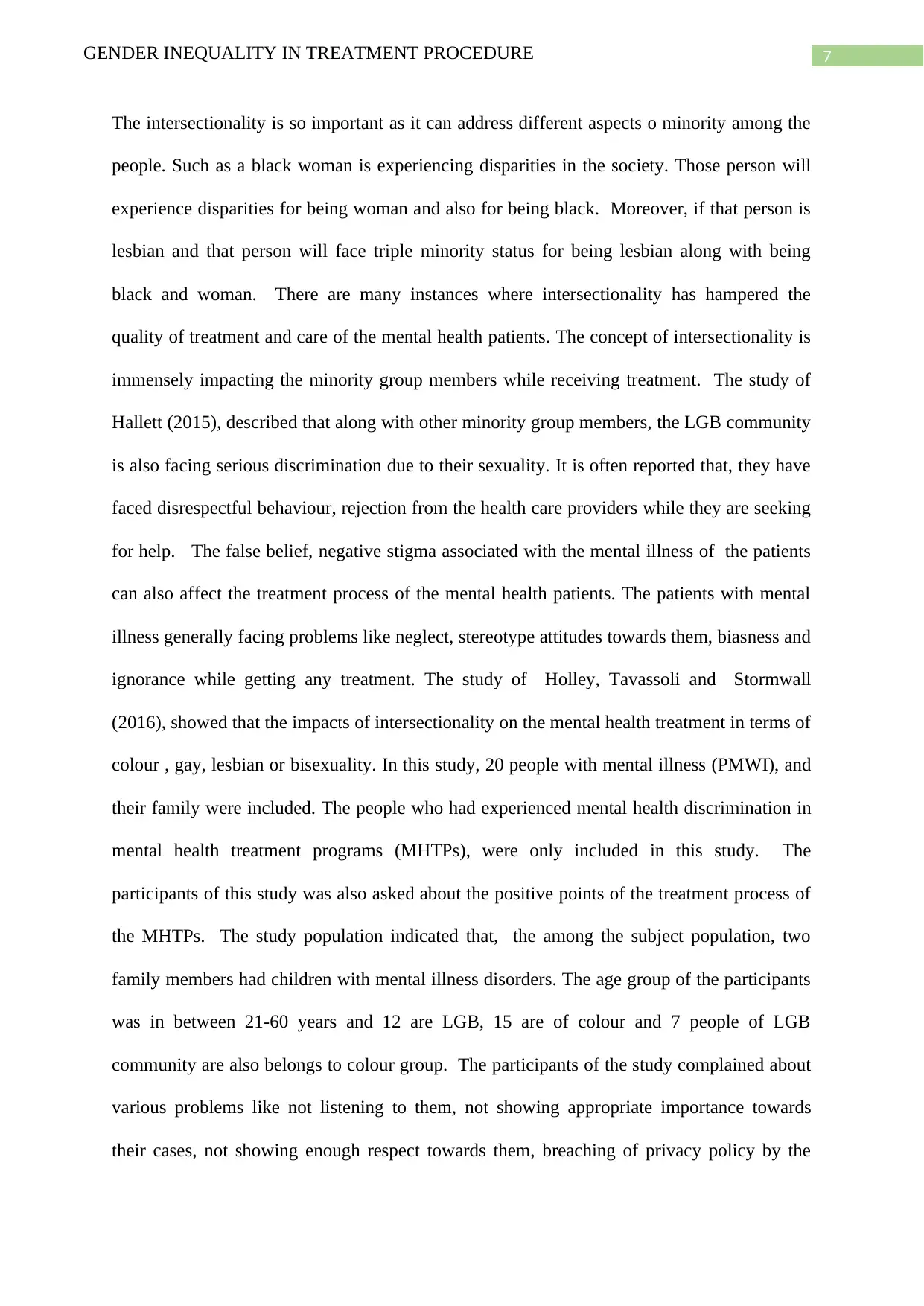
7GENDER INEQUALITY IN TREATMENT PROCEDURE
The intersectionality is so important as it can address different aspects o minority among the
people. Such as a black woman is experiencing disparities in the society. Those person will
experience disparities for being woman and also for being black. Moreover, if that person is
lesbian and that person will face triple minority status for being lesbian along with being
black and woman. There are many instances where intersectionality has hampered the
quality of treatment and care of the mental health patients. The concept of intersectionality is
immensely impacting the minority group members while receiving treatment. The study of
Hallett (2015), described that along with other minority group members, the LGB community
is also facing serious discrimination due to their sexuality. It is often reported that, they have
faced disrespectful behaviour, rejection from the health care providers while they are seeking
for help. The false belief, negative stigma associated with the mental illness of the patients
can also affect the treatment process of the mental health patients. The patients with mental
illness generally facing problems like neglect, stereotype attitudes towards them, biasness and
ignorance while getting any treatment. The study of Holley, Tavassoli and Stormwall
(2016), showed that the impacts of intersectionality on the mental health treatment in terms of
colour , gay, lesbian or bisexuality. In this study, 20 people with mental illness (PMWI), and
their family were included. The people who had experienced mental health discrimination in
mental health treatment programs (MHTPs), were only included in this study. The
participants of this study was also asked about the positive points of the treatment process of
the MHTPs. The study population indicated that, the among the subject population, two
family members had children with mental illness disorders. The age group of the participants
was in between 21-60 years and 12 are LGB, 15 are of colour and 7 people of LGB
community are also belongs to colour group. The participants of the study complained about
various problems like not listening to them, not showing appropriate importance towards
their cases, not showing enough respect towards them, breaching of privacy policy by the
The intersectionality is so important as it can address different aspects o minority among the
people. Such as a black woman is experiencing disparities in the society. Those person will
experience disparities for being woman and also for being black. Moreover, if that person is
lesbian and that person will face triple minority status for being lesbian along with being
black and woman. There are many instances where intersectionality has hampered the
quality of treatment and care of the mental health patients. The concept of intersectionality is
immensely impacting the minority group members while receiving treatment. The study of
Hallett (2015), described that along with other minority group members, the LGB community
is also facing serious discrimination due to their sexuality. It is often reported that, they have
faced disrespectful behaviour, rejection from the health care providers while they are seeking
for help. The false belief, negative stigma associated with the mental illness of the patients
can also affect the treatment process of the mental health patients. The patients with mental
illness generally facing problems like neglect, stereotype attitudes towards them, biasness and
ignorance while getting any treatment. The study of Holley, Tavassoli and Stormwall
(2016), showed that the impacts of intersectionality on the mental health treatment in terms of
colour , gay, lesbian or bisexuality. In this study, 20 people with mental illness (PMWI), and
their family were included. The people who had experienced mental health discrimination in
mental health treatment programs (MHTPs), were only included in this study. The
participants of this study was also asked about the positive points of the treatment process of
the MHTPs. The study population indicated that, the among the subject population, two
family members had children with mental illness disorders. The age group of the participants
was in between 21-60 years and 12 are LGB, 15 are of colour and 7 people of LGB
community are also belongs to colour group. The participants of the study complained about
various problems like not listening to them, not showing appropriate importance towards
their cases, not showing enough respect towards them, breaching of privacy policy by the
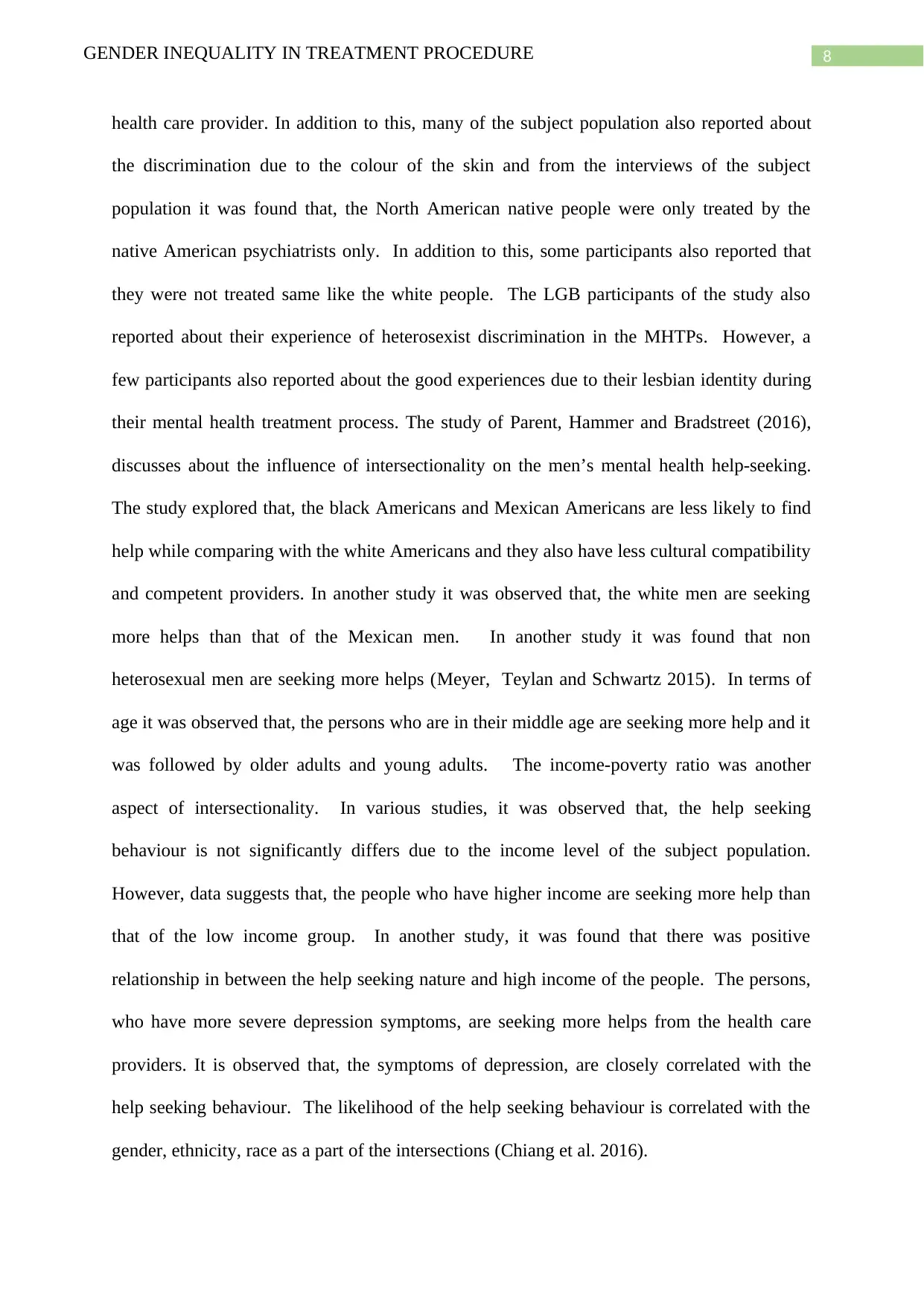
8GENDER INEQUALITY IN TREATMENT PROCEDURE
health care provider. In addition to this, many of the subject population also reported about
the discrimination due to the colour of the skin and from the interviews of the subject
population it was found that, the North American native people were only treated by the
native American psychiatrists only. In addition to this, some participants also reported that
they were not treated same like the white people. The LGB participants of the study also
reported about their experience of heterosexist discrimination in the MHTPs. However, a
few participants also reported about the good experiences due to their lesbian identity during
their mental health treatment process. The study of Parent, Hammer and Bradstreet (2016),
discusses about the influence of intersectionality on the men’s mental health help-seeking.
The study explored that, the black Americans and Mexican Americans are less likely to find
help while comparing with the white Americans and they also have less cultural compatibility
and competent providers. In another study it was observed that, the white men are seeking
more helps than that of the Mexican men. In another study it was found that non
heterosexual men are seeking more helps (Meyer, Teylan and Schwartz 2015). In terms of
age it was observed that, the persons who are in their middle age are seeking more help and it
was followed by older adults and young adults. The income-poverty ratio was another
aspect of intersectionality. In various studies, it was observed that, the help seeking
behaviour is not significantly differs due to the income level of the subject population.
However, data suggests that, the people who have higher income are seeking more help than
that of the low income group. In another study, it was found that there was positive
relationship in between the help seeking nature and high income of the people. The persons,
who have more severe depression symptoms, are seeking more helps from the health care
providers. It is observed that, the symptoms of depression, are closely correlated with the
help seeking behaviour. The likelihood of the help seeking behaviour is correlated with the
gender, ethnicity, race as a part of the intersections (Chiang et al. 2016).
health care provider. In addition to this, many of the subject population also reported about
the discrimination due to the colour of the skin and from the interviews of the subject
population it was found that, the North American native people were only treated by the
native American psychiatrists only. In addition to this, some participants also reported that
they were not treated same like the white people. The LGB participants of the study also
reported about their experience of heterosexist discrimination in the MHTPs. However, a
few participants also reported about the good experiences due to their lesbian identity during
their mental health treatment process. The study of Parent, Hammer and Bradstreet (2016),
discusses about the influence of intersectionality on the men’s mental health help-seeking.
The study explored that, the black Americans and Mexican Americans are less likely to find
help while comparing with the white Americans and they also have less cultural compatibility
and competent providers. In another study it was observed that, the white men are seeking
more helps than that of the Mexican men. In another study it was found that non
heterosexual men are seeking more helps (Meyer, Teylan and Schwartz 2015). In terms of
age it was observed that, the persons who are in their middle age are seeking more help and it
was followed by older adults and young adults. The income-poverty ratio was another
aspect of intersectionality. In various studies, it was observed that, the help seeking
behaviour is not significantly differs due to the income level of the subject population.
However, data suggests that, the people who have higher income are seeking more help than
that of the low income group. In another study, it was found that there was positive
relationship in between the help seeking nature and high income of the people. The persons,
who have more severe depression symptoms, are seeking more helps from the health care
providers. It is observed that, the symptoms of depression, are closely correlated with the
help seeking behaviour. The likelihood of the help seeking behaviour is correlated with the
gender, ethnicity, race as a part of the intersections (Chiang et al. 2016).

9GENDER INEQUALITY IN TREATMENT PROCEDURE
Lastly it can be concluded that, the issue of gender inequality is one of the major problem of
the health care sector. Altough the problem is observed in many health care sector, still the
mental health treatment sector is one the major area of concern. Various instances showed
that, the impact of gender inequality is affecting the mental health treatment sector in a
immense way. In most of the cases , women are in the deprived side. As a part of the
intersectionality gender, race, ethnicity also contributed to the deprivation of treatment of that
particular population. In addition, the LGBT community is another key area of concern in
terms of health inequality of that particular community.
Lastly it can be concluded that, the issue of gender inequality is one of the major problem of
the health care sector. Altough the problem is observed in many health care sector, still the
mental health treatment sector is one the major area of concern. Various instances showed
that, the impact of gender inequality is affecting the mental health treatment sector in a
immense way. In most of the cases , women are in the deprived side. As a part of the
intersectionality gender, race, ethnicity also contributed to the deprivation of treatment of that
particular population. In addition, the LGBT community is another key area of concern in
terms of health inequality of that particular community.
Secure Best Marks with AI Grader
Need help grading? Try our AI Grader for instant feedback on your assignments.
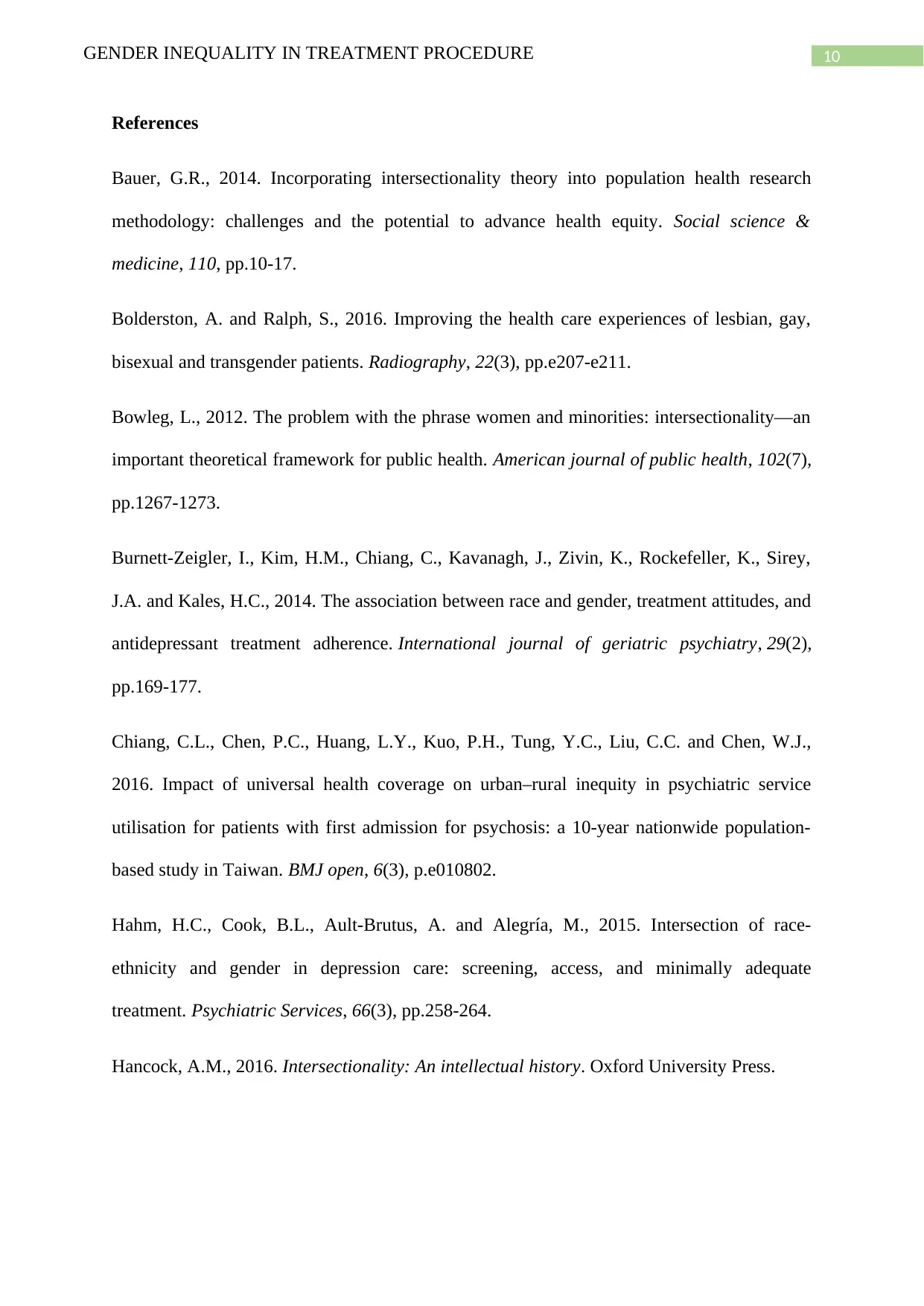
10GENDER INEQUALITY IN TREATMENT PROCEDURE
References
Bauer, G.R., 2014. Incorporating intersectionality theory into population health research
methodology: challenges and the potential to advance health equity. Social science &
medicine, 110, pp.10-17.
Bolderston, A. and Ralph, S., 2016. Improving the health care experiences of lesbian, gay,
bisexual and transgender patients. Radiography, 22(3), pp.e207-e211.
Bowleg, L., 2012. The problem with the phrase women and minorities: intersectionality—an
important theoretical framework for public health. American journal of public health, 102(7),
pp.1267-1273.
Burnett‐Zeigler, I., Kim, H.M., Chiang, C., Kavanagh, J., Zivin, K., Rockefeller, K., Sirey,
J.A. and Kales, H.C., 2014. The association between race and gender, treatment attitudes, and
antidepressant treatment adherence. International journal of geriatric psychiatry, 29(2),
pp.169-177.
Chiang, C.L., Chen, P.C., Huang, L.Y., Kuo, P.H., Tung, Y.C., Liu, C.C. and Chen, W.J.,
2016. Impact of universal health coverage on urban–rural inequity in psychiatric service
utilisation for patients with first admission for psychosis: a 10-year nationwide population-
based study in Taiwan. BMJ open, 6(3), p.e010802.
Hahm, H.C., Cook, B.L., Ault-Brutus, A. and Alegría, M., 2015. Intersection of race-
ethnicity and gender in depression care: screening, access, and minimally adequate
treatment. Psychiatric Services, 66(3), pp.258-264.
Hancock, A.M., 2016. Intersectionality: An intellectual history. Oxford University Press.
References
Bauer, G.R., 2014. Incorporating intersectionality theory into population health research
methodology: challenges and the potential to advance health equity. Social science &
medicine, 110, pp.10-17.
Bolderston, A. and Ralph, S., 2016. Improving the health care experiences of lesbian, gay,
bisexual and transgender patients. Radiography, 22(3), pp.e207-e211.
Bowleg, L., 2012. The problem with the phrase women and minorities: intersectionality—an
important theoretical framework for public health. American journal of public health, 102(7),
pp.1267-1273.
Burnett‐Zeigler, I., Kim, H.M., Chiang, C., Kavanagh, J., Zivin, K., Rockefeller, K., Sirey,
J.A. and Kales, H.C., 2014. The association between race and gender, treatment attitudes, and
antidepressant treatment adherence. International journal of geriatric psychiatry, 29(2),
pp.169-177.
Chiang, C.L., Chen, P.C., Huang, L.Y., Kuo, P.H., Tung, Y.C., Liu, C.C. and Chen, W.J.,
2016. Impact of universal health coverage on urban–rural inequity in psychiatric service
utilisation for patients with first admission for psychosis: a 10-year nationwide population-
based study in Taiwan. BMJ open, 6(3), p.e010802.
Hahm, H.C., Cook, B.L., Ault-Brutus, A. and Alegría, M., 2015. Intersection of race-
ethnicity and gender in depression care: screening, access, and minimally adequate
treatment. Psychiatric Services, 66(3), pp.258-264.
Hancock, A.M., 2016. Intersectionality: An intellectual history. Oxford University Press.
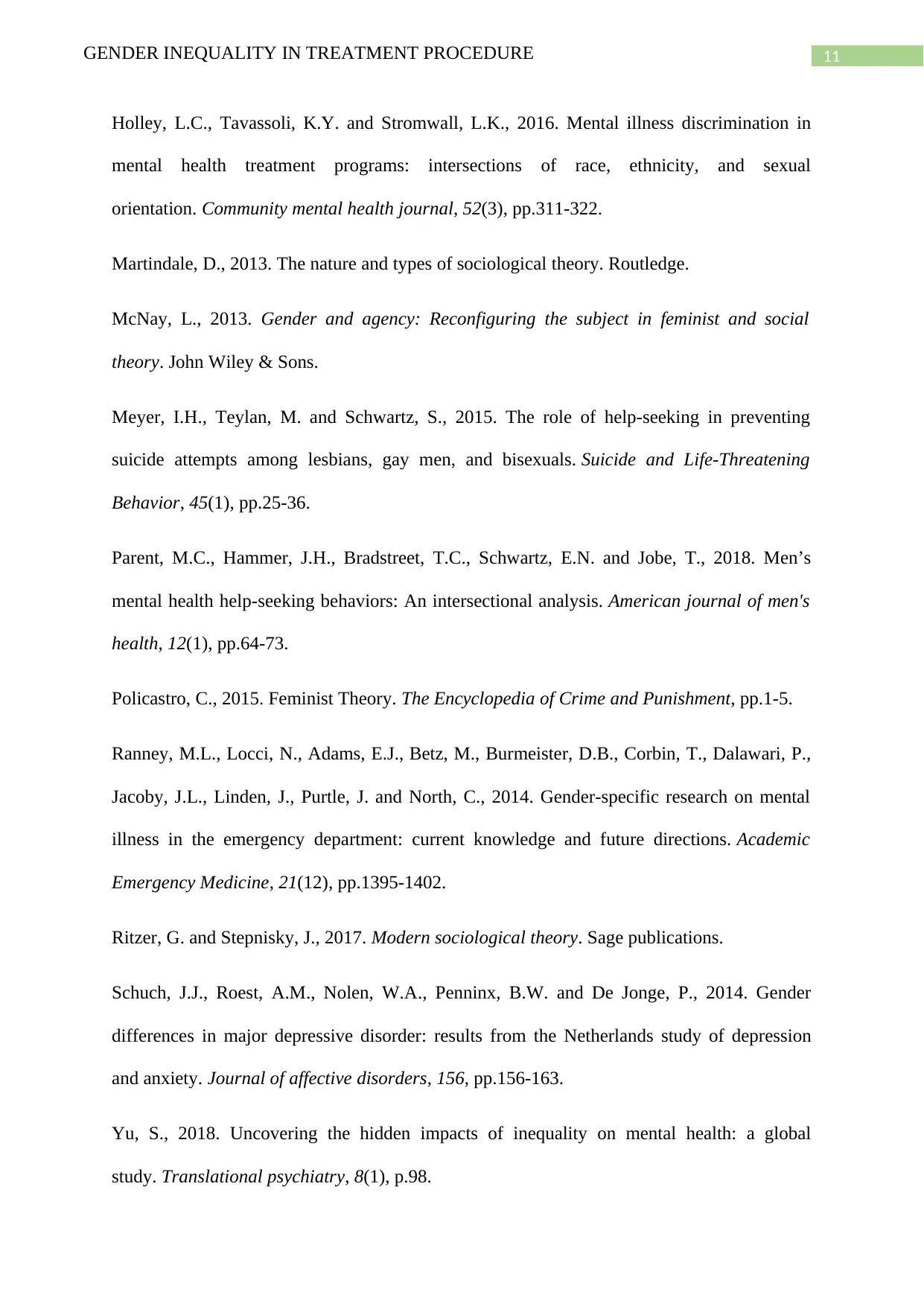
11GENDER INEQUALITY IN TREATMENT PROCEDURE
Holley, L.C., Tavassoli, K.Y. and Stromwall, L.K., 2016. Mental illness discrimination in
mental health treatment programs: intersections of race, ethnicity, and sexual
orientation. Community mental health journal, 52(3), pp.311-322.
Martindale, D., 2013. The nature and types of sociological theory. Routledge.
McNay, L., 2013. Gender and agency: Reconfiguring the subject in feminist and social
theory. John Wiley & Sons.
Meyer, I.H., Teylan, M. and Schwartz, S., 2015. The role of help‐seeking in preventing
suicide attempts among lesbians, gay men, and bisexuals. Suicide and Life‐Threatening
Behavior, 45(1), pp.25-36.
Parent, M.C., Hammer, J.H., Bradstreet, T.C., Schwartz, E.N. and Jobe, T., 2018. Men’s
mental health help-seeking behaviors: An intersectional analysis. American journal of men's
health, 12(1), pp.64-73.
Policastro, C., 2015. Feminist Theory. The Encyclopedia of Crime and Punishment, pp.1-5.
Ranney, M.L., Locci, N., Adams, E.J., Betz, M., Burmeister, D.B., Corbin, T., Dalawari, P.,
Jacoby, J.L., Linden, J., Purtle, J. and North, C., 2014. Gender‐specific research on mental
illness in the emergency department: current knowledge and future directions. Academic
Emergency Medicine, 21(12), pp.1395-1402.
Ritzer, G. and Stepnisky, J., 2017. Modern sociological theory. Sage publications.
Schuch, J.J., Roest, A.M., Nolen, W.A., Penninx, B.W. and De Jonge, P., 2014. Gender
differences in major depressive disorder: results from the Netherlands study of depression
and anxiety. Journal of affective disorders, 156, pp.156-163.
Yu, S., 2018. Uncovering the hidden impacts of inequality on mental health: a global
study. Translational psychiatry, 8(1), p.98.
Holley, L.C., Tavassoli, K.Y. and Stromwall, L.K., 2016. Mental illness discrimination in
mental health treatment programs: intersections of race, ethnicity, and sexual
orientation. Community mental health journal, 52(3), pp.311-322.
Martindale, D., 2013. The nature and types of sociological theory. Routledge.
McNay, L., 2013. Gender and agency: Reconfiguring the subject in feminist and social
theory. John Wiley & Sons.
Meyer, I.H., Teylan, M. and Schwartz, S., 2015. The role of help‐seeking in preventing
suicide attempts among lesbians, gay men, and bisexuals. Suicide and Life‐Threatening
Behavior, 45(1), pp.25-36.
Parent, M.C., Hammer, J.H., Bradstreet, T.C., Schwartz, E.N. and Jobe, T., 2018. Men’s
mental health help-seeking behaviors: An intersectional analysis. American journal of men's
health, 12(1), pp.64-73.
Policastro, C., 2015. Feminist Theory. The Encyclopedia of Crime and Punishment, pp.1-5.
Ranney, M.L., Locci, N., Adams, E.J., Betz, M., Burmeister, D.B., Corbin, T., Dalawari, P.,
Jacoby, J.L., Linden, J., Purtle, J. and North, C., 2014. Gender‐specific research on mental
illness in the emergency department: current knowledge and future directions. Academic
Emergency Medicine, 21(12), pp.1395-1402.
Ritzer, G. and Stepnisky, J., 2017. Modern sociological theory. Sage publications.
Schuch, J.J., Roest, A.M., Nolen, W.A., Penninx, B.W. and De Jonge, P., 2014. Gender
differences in major depressive disorder: results from the Netherlands study of depression
and anxiety. Journal of affective disorders, 156, pp.156-163.
Yu, S., 2018. Uncovering the hidden impacts of inequality on mental health: a global
study. Translational psychiatry, 8(1), p.98.
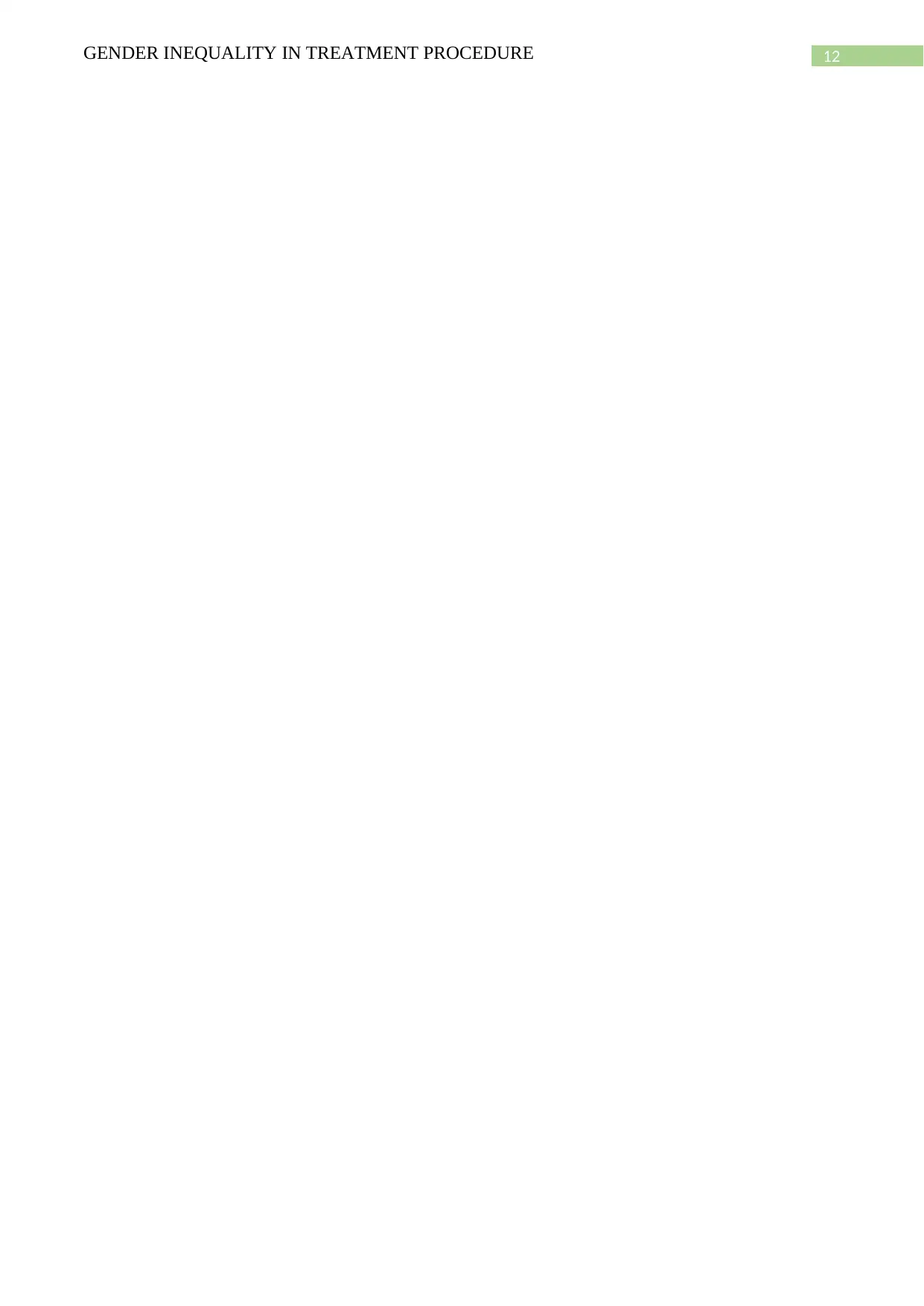
12GENDER INEQUALITY IN TREATMENT PROCEDURE
1 out of 13
Related Documents
Your All-in-One AI-Powered Toolkit for Academic Success.
+13062052269
info@desklib.com
Available 24*7 on WhatsApp / Email
![[object Object]](/_next/static/media/star-bottom.7253800d.svg)
Unlock your academic potential
© 2024 | Zucol Services PVT LTD | All rights reserved.





